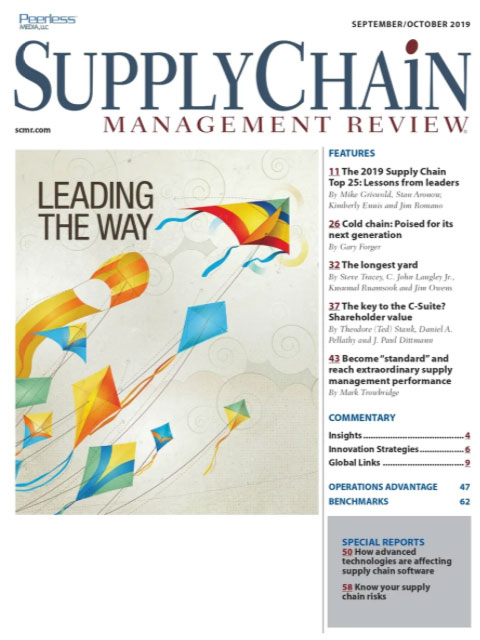Sorry, but your login has failed. Please recheck your login information and resubmit. If your subscription has expired, renew here.
September-October 2019
It’s that time of year again, when we feature the Top 25 supply chains from Gartner. What I enjoy most about this research is the window it provides into where supply chains are going next: After all, while some lead, the rest of us follow. Browse this issue archive.Need Help? Contact customer service 847-559-7581 More options
When Supply Chain Management Review was invited to join the advisory board for “USC’s Annual Global Supply Chain Excellence Summit,” organizers suggested that we help them examine the complexity of today’s humanitarian supply chains by speaking with several key practitioners. In the roundtable discussion I moderated, three prominent leaders shared their impressions of the current state of this dynamic industry sector.
Kathy Fulton is the executive director of the American Logistics Aid Network (ALAN), which responds with logistical support to overseas destinations and our own domestic emergencies. Benjamin Labrot is the Founder and CEO of Floating Doctors, a nonprofit organization out of California that provides free medical care to remote villages and communities in Central America reached mainly by boat. Susy Schöneberg is head of Flexport.org, which recently forged a new partnership with MedShare, leveraging reverse logistics to recycle medical supplies and equipment.
Supply Chain Management Review: What are the greatest challenges you are facing this year?
KATHY FULTON: ALAN faces similar challenges to many other organizations—the uncertainty of demand caused by disasters, and the uncertainty of supply due to geography or market conditions. In disaster relief, you don’t know when or where your help will be needed, or to what extent. It is hard to get good analytics or predictable demand when disasters by nature are unpredictable. And because we rely on the supply chain community to donate their services or expertise to fulfill our mission, there can be a great deal of variability depending on geography and market conditions.
BENJAMIN LABROT: I agree with Kathy. Our greatest supply chain challenges this year are a “perfect storm“ of factors including constantly changing pharmaceutical approvals in multiple countries. Then there is the volatility of importation laws and a very high inconsistency in enforcement. Finally, there’s the high cost of shipping quantities of medication and clinical supplies for our nonprofit medical mission team, now that we have achieved a certain level of capacity. Our organization still has many characteristics of a small “mom and pop” operation, yet has a gross revenue of just under $1 million per year and provides care for over 10,000 patients annually.

This complete article is available to subscribers only.
Log in now for full access or start your PLUS+ subscription for instant access.
SC
MR
Sorry, but your login has failed. Please recheck your login information and resubmit. If your subscription has expired, renew here.
September-October 2019
It’s that time of year again, when we feature the Top 25 supply chains from Gartner. What I enjoy most about this research is the window it provides into where supply chains are going next: After all, while some… Browse this issue archive. Access your online digital edition. Download a PDF file of the September-October 2019 issue.When Supply Chain Management Review was invited to join the advisory board for “USC's Annual Global Supply Chain Excellence Summit,” organizers suggested that we help them examine the complexity of today's humanitarian supply chains by speaking with several key practitioners. In the roundtable discussion I moderated, three prominent leaders shared their impressions of the current state of this dynamic industry sector.
Kathy Fulton is the executive director of the American Logistics Aid Network (ALAN), which responds with logistical support to overseas destinations and our own domestic emergencies. Benjamin Labrot is the Founder and CEO of Floating Doctors, a nonprofit organization out of California that provides free medical care to remote villages and communities in Central America reached mainly by boat. Susy Schöneberg is head of Flexport.org, which recently forged a new partnership with MedShare, leveraging reverse logistics to recycle medical supplies and equipment.
Supply Chain Management Review: What are the greatest challenges you are facing this year?
KATHY FULTON: ALAN faces similar challenges to many other organizations—the uncertainty of demand caused by disasters, and the uncertainty of supply due to geography or market conditions. In disaster relief, you don't know when or where your help will be needed, or to what extent. It is hard to get good analytics or predictable demand when disasters by nature are unpredictable. And because we rely on the supply chain community to donate their services or expertise to fulfill our mission, there can be a great deal of variability depending on geography and market conditions.
BENJAMIN LABROT: I agree with Kathy. Our greatest supply chain challenges this year are a “perfect storm“ of factors including constantly changing pharmaceutical approvals in multiple countries. Then there is the volatility of importation laws and a very high inconsistency in enforcement. Finally, there's the high cost of shipping quantities of medication and clinical supplies for our nonprofit medical mission team, now that we have achieved a certain level of capacity. Our organization still has many characteristics of a small “mom and pop” operation, yet has a gross revenue of just under $1 million per year and provides care for over 10,000 patients annually.
 SUBSCRIBERS: Click here to download PDF of the full article.
SUBSCRIBERS: Click here to download PDF of the full article.
SC
MR


Latest Supply Chain News
- Few executives believe their supply chains can respond quickly to disruptions
- Technology’s role in mending supply chain fragility after recent disruptions
- Tech investments bring revenue increases, survey finds
- Survey reveals strategies for addressing supply chain, logistics labor shortages
- Israel, Ukraine aid package to increase pressure on aerospace and defense supply chains
- More News
Latest Podcast

 Explore
Explore
Procurement & Sourcing News
- Israel, Ukraine aid package to increase pressure on aerospace and defense supply chains
- How CPG brands can deliver on supplier diversity promises
- How S&OP provides the answer to in-demand products
- There is still work to do to achieve supply chain stability
- Blooming success: The vital role of S&OE in nurturing global supply chains
- How one small part held up shipments of thousands of autos
- More Procurement & Sourcing
Latest Procurement & Sourcing Resources

Subscribe

Supply Chain Management Review delivers the best industry content.

Editors’ Picks






